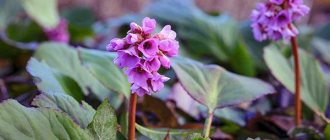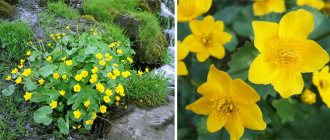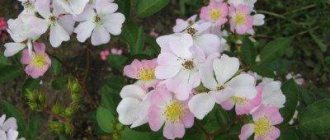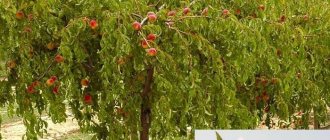Description and history of the appearance of the variety
The climbing rose Polka was bred in 1991 in the French nursery Meilland. The very next year the plant was presented at an exhibition in the USA. Upon registration, the hybrid was named MEItosier; it is also known under the designation Polka 91.
The climbing variety Polka is a dense, spreading bush with a height of 1.2 to 3.5 m. It grows up to 2 m in width. In temperate climates, its size does not exceed 2 m. The shoots of the plant are strong, powerful, and covered with thorns. Its leaves are dark green, numerous, with a glossy surface.
The climbing rose Polka produces large double flowers measuring 10 - 12 cm. Each bud contains more than 35 petals with wavy edges. The shape of the flower changes depending on the stage of development. The buds have a conical shape; over time, the inflorescences become goblet-shaped.
The flowers of the plant are single or collected in 3 - 5 pieces. in lush brushes. Usually apricot in color; when exposed to the sun, they lose their saturation and turn pinkish-salmon. The aroma of climbing rose is weak.
Main characteristics
Let's look at the key features of the variety presented in the table:
| Parameter | Characteristic |
| Culture | Rose (Rosa L.) |
| Variety | “Polka” (Polka, Polka 91, MEItosier, Lord Byron, Scented Dawn, Twilight Glow) |
| Garden group | Largeflowered Climber (LCL) |
| Form | Bush |
| Life cycle | perennial |
| Purpose | Decorative |
| Reproduction | Vegetative (by cuttings) |
| Bush height | 120-350 cm |
| Flowering type | Reblooming |
| Flowering period | June – September |
| Type of flower | Dense double |
| Number of petals | 65-100 pcs. |
| Flower diameter | 7-12 cm |
| Petal coloring | Apricot |
| Disease resistance | Average |
| Frost resistance | Up to −23 ℃ |
| Registration in the State Register of the Russian Federation | Absent |
Advantages and disadvantages of the variety
The main advantages of growing the climbing rose Polka:
- unusual color of flowers;
- numerous buds;
- extended flowering period;
- simple propagation by cuttings;
- The plant's resistance to diseases is above average.
Disadvantages of the Polka variety:
- average winter hardiness;
- the presence of thorns on the shoots;
- need for care.
Diseases and pests
Rosa Polka can be affected by the following diseases:
- gray rot;
- bark burn;
- bacterial cancer.
It is impossible to save a plant from cancer. The only method to combat this disease is proper care and prevention.
The most dangerous flower pests are aphids and garden ants. To combat them, gardeners use insecticides.
To make the garden beautiful and unique, climbing roses are suitable. The Polka rose will especially delight you with its fragrance. It not only produces a large number of delicate flowers, but also fills the garden with a unique aroma.
Video: appearance of the Polka rose
Features of growing Polka roses
When growing the climbing rose Polka, planting rules are followed. Choose a time for work when the plant can best adapt to a new location. Then the area is prepared and, if necessary, the composition of the soil is improved.
Landing dates
The climbing rose Polka is planted in the spring: at the end of April or the first half of May. In the south, work is carried out in the fall, before the cold sets in. 3 - 4 weeks before frost, seedlings will be able to adapt to new conditions.
Advice! If a seedling is purchased in the fall, and the planting time has passed, then it is buried in the ground, covered with sawdust or dry leaves until spring.
Site selection and soil preparation
For the climbing hybrid Polka, choose a sunny area that is well lit in the first half of the day. The place should be well ventilated, but not exposed to cold wind. The best option for a climbing plant is walls and supports on the southwest and south sides. The permissible groundwater level should be no higher than 1 m.
Climbing varieties prefer loamy soils that allow moisture and air to pass through well. The soil begins to be prepared in the fall. The beds are dug up, after which 1 sq. m add 10 g of manure or humus, 400 g of bone meal, 50 g of superphosphate, 200 g of wood ash. The substrate is thoroughly mixed. In the spring, deep loosening is carried out before planting.
Selection and preparation of seedlings
Seedlings of the climbing variety Polka are purchased from nurseries, which guarantees the quality of the material. In this case, choose healthy and strong plants, without damage, cracks or other defects. Before planting, the rose is inspected and dry and diseased shoots are removed. Healthy branches are cut to a height of 15 cm and 2 to 4 buds are left. The roots are also trimmed a little.
If the root system of the plant is overdried, it is immersed in warm water for a day. Before starting work, prepare a mash of clay, water and manure, into which the roots of the flower are dipped immediately before planting.
Landing technology
Planting order for the climbing variety Polka:
- A hole measuring 0.5 x 0.5 m is dug in the area.
- A day before planting, add ½ bucket of manure to the pit and water the soil generously.
- Mix equal amounts of fertile soil and humus. The mixture is poured into the hole to form a mound.
- The seedling is placed on top, its roots are straightened and the voids are filled with soil.
- The plant is watered abundantly and hilled.
- The bush is pruned, shoots 15-20 cm high are left above the ground.
- Pour a layer of humus or peat 5 cm thick.
Flower propagation
The main method of propagating Polka is cuttings. This method is unique in that it gives 100% survival rate of cuttings, and the properties and characteristics of the mother bush will remain the same in new flowers.
When is it produced?
Cuttings are made in early June and in the first half of the day. During this period, the plant just begins to form new strong shoots.
Detailed description
The cutting procedure is as follows:
- Cut cuttings 15 centimeters in length with at least 3 growth buds.
- The lower leaf plates are removed and the sections are placed in a solution that stimulates root formation.
- The cuttings are planted in nutrient soil, covered with plastic or film “caps” on top and wait for them to take root.
Rules for caring for Polka roses
In order for the climbing rose Polka to develop well and bloom profusely, it is provided with certain care. The plant is watered and fed with nutrients. In addition, they form the bush and provide protection from diseases, pests and winter frosts.
Watering
Climbing roses require infrequent but abundant watering. Moisture is added on average every 8 - 10 days. Use warm, settled water. After watering, loosen the soil to a depth of 10-15 cm and remove weeds. Avoid stagnation of water in the soil, which leads to rotting of the roots.
Top dressing
In the first year, the climbing plant is not fertilized if nutrients were added during planting. In the future, the bush is fed annually. In spring, nitrogen agents are used to stimulate the growth of shoots and leaves. This includes urea, ammonium nitrate, mullein, and poultry manure.
During flowering and later, Polka roses switch to phosphorus and potassium compounds: superphosphate, potassium salt, wood ash. The use of mineral complexes Nitrofoska, Nitroammofoska, etc. is allowed.
During the season, the Polka rose is fed according to the following scheme:
- in spring, at the beginning of bush development;
- during the formation of buds;
- after flowering;
- during lignification of shoots.
Trimming and shaping
Pruning is an essential step in caring for climbing roses. As a result of the event, a bush is formed that blooms profusely and for a long time. At the same time, the growth of shoots is limited, which fill all the free space and interfere with other plants.
Important! Polka roses are recommended to be pruned in early spring. Strong young shoots are left on the bush.
Rose branches produce inflorescences within 4 - 5 years. Then their ability to form buds weakens. Therefore, shoots older than 4 years are cut off at the root. No more than 3 annual branches are left on the climbing plant. Be sure to remove dry, broken, frozen parts of the bush.
Protection from diseases and pests
Rose variety Polka has average immunity to powdery mildew. The disease appears as white spots that spread quickly in hot and humid weather. The development of the bush slows down, which negatively affects its flowering and decorativeness. To combat and prevent powdery mildew, the rose is sprayed with Bordeaux mixture.
Another dangerous disease of climbing roses is koniothyrium, or bark cancer. It is diagnosed in the spring after the cover is removed. Reddish spots appear on the bark, which increase in size and turn black. The lesion spreads in high humidity. Affected shoots are cut off and burned. To prevent cancer, roses are fed with phosphorus compounds, cover is removed when the weather gets warmer, and nitrogen fertilizing is abandoned in the fall.
Climbing roses are susceptible to attack by aphids and spider mites. Insecticides such as Iskra, Karbofos, Actellik help get rid of pests. Folk remedies include wood ash and onion peel infusion.
Shelter for the winter
The climbing rose Polka requires shelter for the winter. The variety tolerates cold temperatures down to -26 °C. An air gap is left between the material used and the plant. At the end of August, watering and fertilizing are stopped. The shelter is installed when the air temperature reaches -5 °C. The shoots are removed from the support and laid on the ground. Then dry leaves are poured in, a wooden frame and spruce branches are placed on top.
Polka during flowering
The flowers of the Polka rose bush can rightly be called chameleons because they change shade as they bloom. The color of the petals smoothly changes its color scheme. Fully bloomed flowers have a diameter of 11-12 cm. The bush, located on a horizontal support, is strewn with both inflorescences and single flowers.
In order for the root system of a young bush to receive the maximum amount of nutrients, it is recommended to remove the buds in the first year.
In addition, as they wither and dry out, it is worth carefully cutting off the old flowers - this will preserve the attractive appearance of the bush and prevent the depletion of the rose.
If the buds don't appear
When a rose does not bloom, a gardener most often has to blame himself. This is a consequence of flaws in agricultural technology:
- unsuitable soil (clayey, rocky, sandy, acidified, alkaline);
- light deficiency;
- too rare or frequent watering;
- lack of nutrients in the soil or their excess;
- improper pruning of the bush.
Methods of propagation of climbing rose Polka
The Polka rose variety is propagated by cuttings. In summer, cuttings are taken from the bush. Use shoots on which buds appear. The bottom edge is cut at an acute angle. The branches are placed in a substrate of sand and earth. They are covered with glass on top.
Important! Almost 100% of the cuttings of the climbing rose Polka take root.
Cuttings of the Polka variety produce roots without the use of a stimulant. To speed up this process, you can treat the edge with a heteroauxin solution. Rooting takes 2 - 4 weeks. The plants are then transplanted into the greenhouse. Since October, the climbing rose has been kept at a temperature of 5 - 10 ° C. At the end of January the temperature rises to +20 °C. Towards the end of winter, the cuttings are fed with mullein solution. The Polka variety is transferred to its permanent place in May.
Optimal conditions for the flower, it suits all nuances
Polka rose can be planted in both spring and autumn. In temperate regions, the time is from late April to mid-May. In the south, planting may be delayed until September or early October. There should be at least 3-4 weeks before frost.
Optimal conditions for plants:
- An open area protected from cold winds. A fence, wall, trellis, etc., which the polka “mixes,” can play well as obstacles. Ideally, the sun hits the hive in the morning or evening. During the hottest time of the day, partial shade is desirable.
- Nutrient substrate with good aeration - loam, sandy loam. The soil should be neutral or slightly acidic.
- Groundwater comes closer to the surface than a meter. When the substrate is waterlogged, the risk of developing root rot increases. Due to the stagnation of melt and rain water, the polka does not fit in the lowlands.
Without the sun, the polka rose bush simply cannot grow and bloom, but prolonged exposure to direct rays is not very pleasant.
The best show on the survival of two-year-old rose seedlings. They have at least 5-6 flexible roots, not dry or rotten, and several shoots about 25 cm long. The stems should be firm green, without signs of peeling and spots like mold or rot.
Whenever possible, choose rose seedlings from nurseries that are in your area - they are already adapted to the local climate
The depth and diameter of the polka pits is 50-60 cm, put a 5-7 cm thick layer on the bottom, fill with drainage. Fill the hole with purchased rose soil or a mixture of humus, fertile soil, peat chips and sand (2:3:1:1). In the second case, add another 120-150 g of complex fertilizer for roses. The pit is prepared for spring planting in the fall, for autumn planting 2-3 weeks earlier.
The landing procedure itself is not of great importance - this is:
- For a day, soak the roots in warm water or a solution of any biostimulant. Then inspect them, if necessary, cut off necrosis of healthy tissue.
- Lightly moisten the substrate in the planting hole.
- From the soil to form a mound, place the seedling in it so that the roots are on the "slopes" down.
- Fill the hole with soil, periodically reducing the size of his palms. The root collar should be 5-6 cm below ground level.
- Filling the plant consumes 15-20 liters of water. Multiroute earth.
The most important thing in the process of growing roses is to ensure the correct position of the root collar.
Video: procedures for planting seedlings in the ground
Transplanting a polka rose is, in principle, possible, but there are two serious obstacles - the size of an adult bush and the thorny branches. If you nevertheless decide on such a procedure, move the plant to a new place along with a lump of earth on the roots.
Climbing rose Polka in landscape design
With good care, the lifespan of a climbing rose is up to 50 years. Shoots with lush flowers will decorate the walls of houses, fences, gazebos, pergolas and arches. When constructing a trellis, the overgrown bushes will serve as a hedge.
When composing a composition, a climbing rose is made its central part. Its soft peach inflorescences stand out effectively against the background of lawns, evergreen shrubs and trees. Avoid proximity to petunias, begonias, dahlias and other bright flowers. The climbing plant looks advantageous next to crops that have grayish or silvery leaves.
It is allowed to place several climbing varieties nearby. In this case, the compatibility of shades is taken into account. Leave 40 - 50 cm between plants. An unusual option for designing a site is to use a large tree as a support for the rose: broom, larch, pine, yew.











